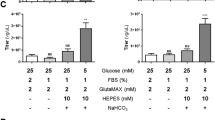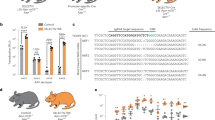Abstract
Recombinant adenoviral vectors have a number of advantages for gene therapy, including transduction of a range of dividing and non-dividing cell types. However, this broad range may be a disadvantage if non-target cells are transduced and are adversely affected by expression of the transferred gene. Here we describe a novel adenoviral vector in which transcription of the transgene is restricted to the patho-physiological condition of low oxygen tension (hypoxia). Hypoxia activates the expression of a number of genes, principally via the stabilisation of members of the bHLH/PAS family of transcription factors that bind to a con- sensus DNA sequence, the hypoxia response element (HRE). We have configured an optimised HRE expression cassette into an adenoviral vector, AdOBHRE. A range of cell types, including primary human skeletal muscle, when transduced with AdOBHRE display a low basal level of transgene expression that is highly induced in hypoxia to levels equivalent to that obtained from the CMV promoter. The AdOBHRE vector could be exploited for transcriptionally targeted gene therapy for the treatment of diseases such as cancer, peripheral arterial disease, arthritis and anaemia where tissue hypoxia is a cardinal feature.
This is a preview of subscription content, access via your institution
Access options
Subscribe to this journal
Receive 12 print issues and online access
$259.00 per year
only $21.58 per issue
Buy this article
- Purchase on Springer Link
- Instant access to full article PDF
Prices may be subject to local taxes which are calculated during checkout



Similar content being viewed by others
References
Dmitriev I et al. An adenovirus vector with genetically modifed fibers demonstrates expanded tropism via utilization of a coxsackievirus and adenovirus receptor-independent cell entry mechanism J Virol 1998 72: 9706–9713
Krasnykh VN, Mikheeva GV, Douglas JT, Curiel DT . Generation of recombinant adenovirus vectors with modified fibers foraltering viral tropism J Virol 1996 70: 6839–6846
Wickham TJ et al. Increased in vitro and in vivo gene transfer by adenovirus vectors containing chimeric fiber proteins J Virol 1997 71: 8221–8229
Kim S et al. Transcriptional targeting of replication-defective adenovirus transgene expression to smooth muscle cells in vivo J Clin Invest 1997 100: 1006–1014
Inesi G et al. Cell-specific promoter in adenovirus vector for transgenic expression of SERCA1 ATPase in cardiac myocytes Am J Physiol 1998 274: C645–C653
Bui LA et al. In vivo therapy of hepatocellular carcinoma with a tumor-specific adenoviral vector expressing interleukin-2 Hum Gene Ther 1997 8: 2173–2182
Dusetti NJ et al. The pancreatitis-associated protein I promoter allows targeting to the pancreas of a foreign gene, whose expression is up-regulated during pancreatic inflammation J Biol Chem 1997 272: 5800–5804
Franz WM, Rothmann T, Frey N, Katus HA . Analysis of tissue-specific gene delivery by recombinant adenoviruses containing cardiac-specific promoters Cardiovasc Res 1997 35: 560–566
Larochelle N et al. Efficient muscle-specific transgene expression after adenovirus-mediated gene transfer in mice using a 1.35 kb muscle creatine kinase promoter/enhancer Gene Therapy 1997 4: 465–472
Dachs GU, Stratford IJ . The molecular response of mammalian cells to hypoxia and the potential for exploitation in cancer therapy Br J Cancer 1996 74: S126–S132
Pugh CW et al. Functional analysis of an oxygen-regulated transcriptional enhancer lying 3′ to the mouse erythropoietin gene Proc Natl Acad Sci USA 1991 88: 10553–10557
Semenza GL, Nejfelt MK, Chi SM, Antonarakis SE . Hypoxia-inducible nuclear factors bind to an enhancer element located 3′ to the human erythropoietin gene Proc Natl Acad Sci USA 1991 88: 5680–5684
Liu Y, Cox SR, Morita T, Kourembanas S . Hypoxia regulates vascular endothelial growth factor gene expression in endothelial cells Circ Res 1995 77: 638–643
Firth JD, Ebert BL, Pugh CW, Ratcliffe PJ . Oxygen-regulated control elements in the phosphoglycerate kinase 1 and lactate dehydrogenase A genes: similarities with the erythropoietin 3′ enhancer Proc Natl Acad Sci USA 1994 91: 6496–6500
Semenza GL, Roth PH, Fang HM, Wang GL . Transcriptional regulation of genes encoding glycolytic enzymes by hypoxia-inducible factor 1 J Biol Chem 1994 269: 23757–23763
Wang GL, Semenza GL . Characterization of hypoxia-inducible factor 1 and regulation of DNA binding activity by hypoxia J Biol Chem 1993 268: 21513–21518
Kallio PJ et al. Activation of hypoxia-inducible factor 1 alpha: post-transcriptional regulation and conformational change by recruitment of the Arnt transcription factor Proc Natl Acad Sci USA 1997 94: 5667–5672
Tian H, McKnight SL, Russell DW . Endothelial PAS domain protein 1 (EPAS1), a transcription factor selectively expressed in endothelial cells Genes Dev 1997 11: 72–82
Wang GL, Jiang BH, Rue EA, Semenza GL . Hypoxia-inducible factor 1 is a basic-helix-loop-helix-PAS heterodimer regulated by cellular O2 tension Proc Natl Acad Sci USA 1995 92: 5510–5514
Huang LE, Arany Z, Livingston DM, Bunn HF . Activation of hypoxia-inducible transcription factor depends primarily upon redox-sensitive stabilisation of its α subunit J Biol Chem 1996 271: 32253–32259
Jiang BH, Semenza GL, Bower C, Marti HH . Hypoxia-inducible factor 1 levels vary over a physiologically relevant range of oxygen tension Am J Physiol 1996 271: 1172–1180
Vaupel PW . Oxygenation of solid tumours In: Teicher BA (ed) . Drug Resistance in Oncology Marcel Dekker: New York 1993 pp 53–85
Rothschild BM, Alfonse TM . Pathogenesis of rheumatoid arthritis: a vascular hypothesis Semin Arth Rheum 1982 12: 11–31
Baumgartner I et al. Constitutive expression of phVEGF165 after intramuscular gene transfer promotes collateral vessel development in patients with chronic limb ischemia Circulation 1998 97: 1114–1123
Dachs GU et al. Targeting gene expression to hypoxic tumour cells Nature Med 1997 3: 515–520
Rinsch C et al. A gene therapy approach to regulated delivery of erythropoietin as a function of oxygen tension Hum Gene Ther 1997 8: 1881–1889
Prentice H et al. Regulated expression of a foreign gene targeted to the ischaemic myocardium Cardiovasc Res 1997 35: 567–574
Setoguchi Y, Danel C, Crystal RG . Stimulation of erythropoiesis by in vivo gene therapy: physiologic consequences of transfer of the human erythropoietin gene to experimental animals using an adenovirus vector Blood 1994 84: 2946–2953
Goldberg MA, Dunning SP, Bunn HF . Regulation of the erythropoietin gene: evidence that the oxygen sensor is a heme protein Science 1988 9: 1412–1415
Marshall DJ, Leiden JM . Recent advances in skeletal-muscle-based gene therapy Curr Opin Genet Dev 1998 8: 360–365
Vaupel P, Schlenger K, Knoop C, Hockel M . Oxygenation of human tumors: evaluation of tissue oxygen distribution inbreast cancers by computerized O2 tension measurements Cancer Res 1991 51: 3316–3322
Brizel DM et al. Tumor hypoxia affects the prognosis of carcinoma of the head and neck Int J Radiat Oncol Biol Phys 1997 38: 285–289
Blatt J . Desferoxamine in children with recurrent neuroblastoma Anticancer Res 1994 14: 2109–2112
Donfrancesco A et al. Deferoxamine followed by cyclophosphamide, etoposide, carboplatin, thiotepa, induction regimen in advanced neuroblastoma: preliminary results. Italian Neuroblastoma Cooperative Group Eur J Cancer 1995 31A: 612–615
Hershko C, Konijn AM, Link G . Iron chelators for thalassaemia Br J Haematol 1998 101: 399–406
Olivieri NF et al. Long term safety and effectiveness of iron-chelation therapy with deferiprone for thalassemia major New Engl J Med 1998 339: 417–423
Agani F, Semenza GL . Mersalyl is a novel inducer of vascular endothelial growth factor gene expression and hypoxia-inducible factor 1 activity Mol Pharmacol 1998 54: 749–754
Zelzer E et al. Insulin induces transcription of target genes through the hypoxia-inducible factor HIF-1alpha/ARNT Embo J 1998 17: 5085–5094
Wickham TJ, Roelvink DW, Brough DE, Kovesdi I . Adenovirus targeted to heparan-containing receptors increases its gene delivery efficiency to multiple cell types Nat Biotech 1996 14: 1570–1573
Shi Q, Wang Y, Worton R . Modulation of the specificity and activity of a cellular promoter in an adenoviral vector Hum Gene Ther 1997 8: 403–410
Miller N, Whelan J . Progress in transcriptionally targeted and regulatable vectors for genetic therapy Hum Gene Ther 1997 8: 803–815
Rossi F, Blau H . Recent advances in inducible gene expression systems Curr Opin Biotechnol 1998 9: 451–456
Svensson EC, Tripathy SK, Leiden JM . Muscle-based gene therapy: realistic possibilities for the future Mol Med Today 1996 2: 166–172
Lowenstein PR, Enquist LW . Protocols for Gene Transfer in Neuroscience: Towards Gene Therapy of Neurological Disorders John Wiley: New York 1996
Boast K et al. Characterisation of physiologically regulated vectors for the treatment of ischaemic disease Gene Therapy (in press)
Author information
Authors and Affiliations
Rights and permissions
About this article
Cite this article
Binley, K., Iqball, S., Kingsman, A. et al. An adenoviral vector regulated by hypoxia for the treatment of ischaemic disease and cancer. Gene Ther 6, 1721–1727 (1999). https://doi.org/10.1038/sj.gt.3301001
Received:
Accepted:
Published:
Issue Date:
DOI: https://doi.org/10.1038/sj.gt.3301001
Keywords
This article is cited by
-
Characterization of neural stem cells modified with hypoxia/neuron-specific VEGF expression system for spinal cord injury
Gene Therapy (2018)
-
Cell-specific gene therapy driven by an optimized hypoxia-regulated vector reduces choroidal neovascularization
Journal of Molecular Medicine (2018)
-
A novel hybrid promoter responsive to pathophysiological and pharmacological regulation
Journal of Molecular Medicine (2012)
-
Lister strain vaccinia virus, a potential therapeutic vector targeting hypoxic tumours
Gene Therapy (2010)



